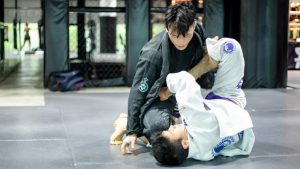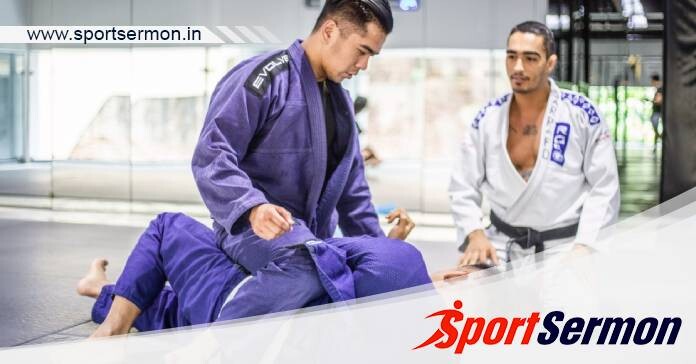BJJ Sit-Up Escapes: Brazilian jiu-jitsu is a dynamic grappling style that has gained popularity among practitioners worldwide. What sets BJJ apart is the freedom to design your own game. This suggests that your grappling technique may be very different from another practitioner’s even if you train at the same gym! One of the best examples of this is Marcelo Garcia, the multiple ADCC and IBJJF champion. He is one of the few grapplers in the history of our sport to have had considerable success in both Gi and No-Gi competitions, collecting several awards along the way. One of his hallmark moves is to use sit-up escapes to stop guard passes. The principles of BJJ sit-up escapes will be covered today.
A Different Take On Defence
BJJ students are usually taught basic tactics like shrimping to create space and regain guard. Not everyone is in support of the shrimping motion, even if it is a perfectly sensible decision, especially when working with bigger and more strong training partners. Instead of lying flat on his back to shrimp and reclaim his guard, Marcelo uses a unique method where he usually sits up while he frames against the opponent to either return to guard or transition to techniques like wrestle-ups, back takes, and front headlocks. Even while this is very standard practise now, many of Marcelo’s opponents were confused and bewildered when he initially put out this idea.
Marcelo uses the sit-up escape as a key component of his open-guard defensive strategy. He starts with the sit-up guard (sitting guard) and then moves on to his favourite guards, which are the single-leg X guard and the butterfly guard.
If the opponent manages to get past your legs and knees, you can use the sit-up guard in the first situation. It’s usually a good idea to start your defence with your legs while guard passes are being made. Because our legs are among the strongest in the body, you can block much bigger opponents by placing yourself correctly.
Guard retention should prioritise utilising the legs, but eventually, this will be overlooked. Once this occurs, a good backup move to prevent your opponent from letting their guard down is to perform a sit-up escape. As soon as your opponent passes your legs, Marcelo advises sitting up. As you use your other arm as an anchor by posting on the ground, use your arms to frame against the neck (push frame or collar tie). They will be forced to either stop the pass or switch to a different tactic as a result. The next objective is to get your legs out of the way so that your opponent can’t drag you onto the mat. It should be rather simple to transition to an offensive cycle once you have completed these procedures.
This is an additional situation when your opponent has already gotten past your defences and is trying to establish top-side dominance. As we previously stated, the optimal course of action would be to utilise your legs to prevent the opponent from slamming into your chest. However, employing the sit-up escape to regain guard is the second-best choice when recovery via the legs is challenging.
Here, the most important thing is to keep the head from being controlled by your opponent. Gaining control of your head will make it much more difficult to move and get away. Sit up with one arm pressed against your neck and the other firmly planted on the ground. Use your arms to frame against the opponent’s far arm, which is the arm trying to control your head. It should be noted that you have the option to sit up even if your opponent is shifting sideways on their hip or if their knees are on the mat. From here, you can either pull your legs away, as seen in the last video or insert them to recover and guard. These are both good strategies to raise your standing.
You might also be interested in reading this: 5 Things That Make BJJ The Best Martial Arts for Seniors
The Attitude Of Never Taking A Pass

A great technique to keep your opponent from flattening you out is the sit-up escape. Fighting from a semi-athletic posture, such as the sit-out position, is far simpler than lying flat on your back. This is particularly true when facing more powerful and larger opponents. It would be better for you if you could figure out how to remain erect.
It’s true that using the sit-up escape in mixed martial arts requires some awareness. Yes, it’s still a really good alternative, but keep in mind that while you’re sitting up, you’ll be vulnerable to blows to the head. When blows are taken into consideration, your greatest choice would be to utilise your legs to pummelled back to guard.
Seated, Oriented, and Active

It is intended that you make active use of the sit-up escape. This suggests that staying motionless after sitting up is not a good idea. If you can, move to a better position as soon as possible. Use your frames to block the opponent.
In summary
It is imperative for all Brazilian Jiu-Jitsu practitioners to learn the sit-up escape. It is without a doubt one of the most adaptable defensive strategies you can pick up to instantly improve your play. Always remember to practise the skills you have selected when you are at the gym. Please make time to practise the sit-up escape in a variety of scenarios. Once you feel comfortable doing so, include it in your sparring sessions. I appreciate you reading this post today, and happy training!
Comprehending BJJ Sit-Up Escapes. Let us know your thoughts in the comment section below.

